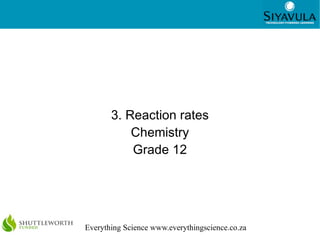
Reaction rates
- 1. 1 3. Reaction rates Chemistry Grade 12 Everything Science www.everythingscience.co.za
- 2. 2 Reaction rates The rate of a reaction describes how quickly reactants are used up, or how quickly products form. The units used are moles per second. A number of factors can affect the rate of a reaction. These include: the nature of the reactants the concentration of reactants temperature of the reaction the presence or absence of a catalyst A fast reaction the surface area of the reactants. A slow reaction Rust by Der Stefan on Flickr Everything Science www.everythingscience.co.za
- 3. 3 Collision theory Collision theory provides one way of explaining why each of these factors can affect the rate of a reaction. For example, higher temperatures mean increased reaction rates because the reactant particles have more energy and are more likely to collide successfully with each other. Everything Science www.everythingscience.co.za
- 4. 4 Measuring reaction rates Different methods can be used to measure the rate of a reaction. The method used will depend on the nature of the product. Reactions that produce gases can be measured by collecting the gas in a syringe. Reactions that produce a precipitate are also easy to measure because the precipitate is easily visible. Everything Science www.everythingscience.co.za
- 5. 5 Energy of reactions For any reaction to occur, a minimum amount of energy is needed so that bonds in the reactants can break, and new bonds can form in the products. The minimum energy that is required is called the activation energy of a reaction. Everything Science www.everythingscience.co.za
- 6. 6 Energy of reactions continued In reactions where the particles do not have enough energy to overcome this activation energy, one of two methods can be used to facilitate a reaction to take place: increase the temperature of the reaction or add a catalyst. Increasing the temperature of a reaction means that the average energy of the reactant particles increases and they are more likely to have enough energy to overcome the activation energy. A catalyst is used to lower the activation energy so that the reaction is more likely to take place. A catalyst does this by providing an alternative, lower energy pathway, for the reaction. A catalyst therefore speeds up a reaction but does not become part of the reaction in any way. Everything Science www.everythingscience.co.za
- 7. 7 Open and closed systems An open system is one whose borders allow the movement of energy and matter into and out of the system. A closed system is one in which only energy can be exchanged, but not matter. Everything Science www.everythingscience.co.za
- 8. 8 Reversible reactions A reversible reaction is a chemical reaction that can proceed in both the forward and reverse directions. In other words, the reactant and product of one reaction may reverse roles. We can represent this using a double headed arrow. A reversible reaction Everything Science www.everythingscience.co.za
- 9. 9 Chemical equilibrium Chemical equilibrium is the state of a reaction, where the concentrations of the reactants and the products have no net change over time. Usually this occurs when the rate of the forward reaction is the same as the rate of the reverse reaction. Everything Science www.everythingscience.co.za
- 10. 10 Equilibrium constant The equilibrium constant relates to reactions at equilibrium, and can be calculated using the following equation: [C]c [D]d K c= a b [ A] [B] where A and B are reactants, C and D are products and a, b, c, and d are the coefficients of the respective reactants and products. A high Kc value means that the concentration of products at equilibrium is high and the reaction has a high yield. A low Kc value means that the concentration of products at equilibrium is low and the reaction has a low yield. Everything Science www.everythingscience.co.za
- 11. 11 Le Chatelier's principle Le Chatelier’s principle states that if a chemical system at equilibrium experiences a change in concentration, temperature or total pressure the equilibrium will shift in order to minimise that change and to re-establish equilibrium. For example, if the pressure of a gaseous system at equilibrium was increased, the equilibrium would shift to favour the reaction that produces the lowest quantity of the gas. If the temperature of the same system was to increase, the equilibrium would shift to favour the endothermic reaction. Similar principles apply for changes in concentration of the reactants or products in a reaction. The principles of equilibrium are very important in industrial applications such as the Haber process, so that productivity can be maximised. Everything Science www.everythingscience.co.za
- 12. 12 For more practice or to ask an expert for help on this section see: www.everythingscience.co.za Shortcode: ESCAQ Everything Science www.everythingscience.co.za
